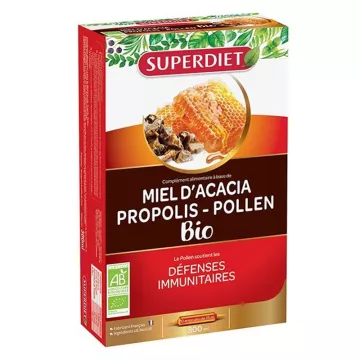Need a natural ally to boost your defenses or soothe the little aches and pains of everyday life? Organic honey offers much more than a simple taste pleasure. Rich in enzymes, vitamins, minerals and antioxidants, it helps boost immunity, soothe inflammation and promote healing. Selected for their purity and rigorously controlled floral origin, our organic honeys combine therapeutic quality with respect for the environment, for healthy, safe and certified consumption.
More details

In naturopathy, apitherapy - which uses the treasures of the hive such as royal jelly, pollen and propolis - is a valuable natural approach to boosting defenses, supporting vital energy and stimulating cognitive functions.
Honey is made by bees from flower nectar. It is mainly used to sweeten food. But it also has a number of health benefits. Honey is made up of around 80% sugar (glucose, fructose, maltose) and 20% water. Honey also contains pollen residues, a source of vitamins (B1 to B9), trace elements (potassium, magnesium, calcium, etc.), proteins, lipids, acids and enzymes. This rich composition gives it many virtues:
Many types of honey can be found on market stalls. As tastes evolve, here are the most familiar to consumers.
Honey is mainly made up of carbohydrates, accounting for around 80% of its total composition. These sugars, such as glucose, fructose and maltose, are easily assimilated by the body, making them a rapid source of energy. The remainder of honey is made up of :
This category of honey has a distinctive taste that evokes the flower from which it comes.
Other honeys are named after the way they are grown. For example, some honeys called " mountain honeys " come from the flowers of high-altitude meadows, and therefore have the properties of several plants as well as pronounced flavors. The color of this honey can range from brown to whitish, depending on the concentration of oak and box honeydew in the region. The term " all-flower honey " refers to honey harvested at the end of each season and grown over several flowering seasons. Its taste reflects the flowers of the entire region from which it comes.
As their name suggests, spring and summer honeys are obtained from flowers blooming in these seasons. The former is clear and has a delicate scent, coming from various trees, boxwood, acacia or lime blossoms, sometimes giving rise to the famous lime honey. The second comes from a variety of flowers that bloom in summer, including lavender, sunflower and honeysuckle.
The honey market is constantly expanding. Indeed, changes in agriculture have led to the gradual disappearance of clover, sainfoin and alfalfa honeys, which were once highly prized. With time, and the introduction of other varieties and flavors from France's neighboring countries and overseas departments, we're learning about other crops.
From Italy, for example, arbutus honey is renowned for its slight bitterness and is much appreciated by gourmets. Introduced to the market in the last decade, metcalfa honey, a luscious, fruity brown honey, is mainly grown in the Mediterranean. Fir honey is a dark, even blackish honey, much in demand for its mild taste.
Soin-et-Nature offers a selection of products from the hive, recognized for their natural benefits to health and well-being. Here are the categories available:
These hive products available on Soin-et-Nature allow you to take full advantage of nature's treasures, while supporting your health and well-being on a daily basis.